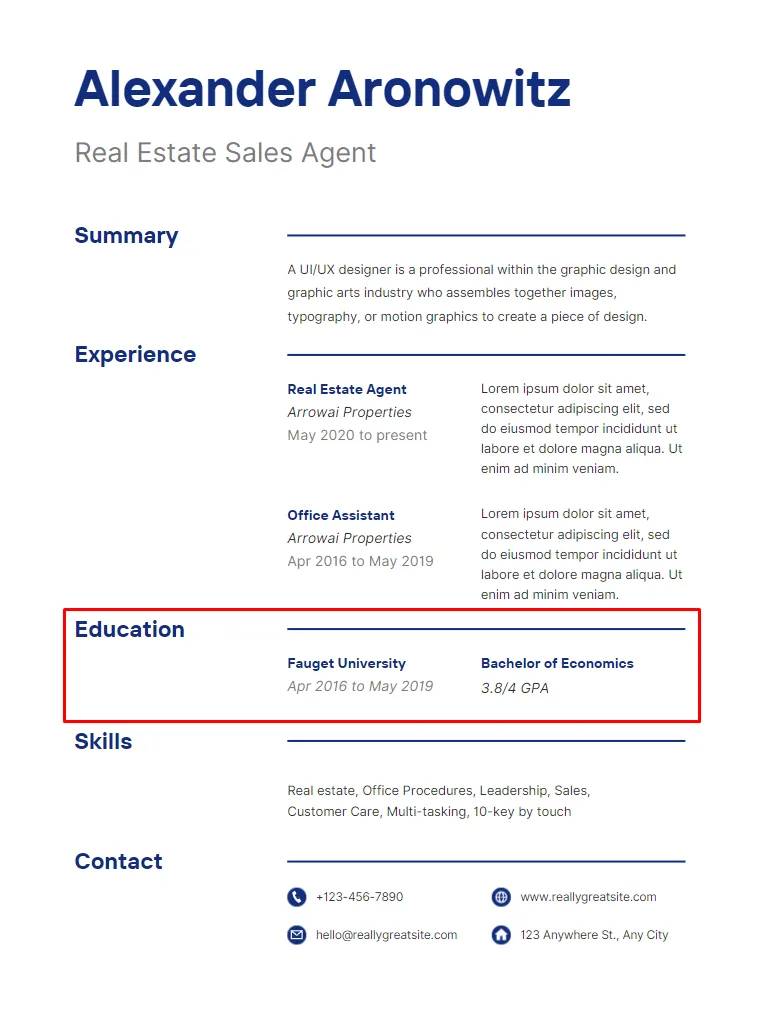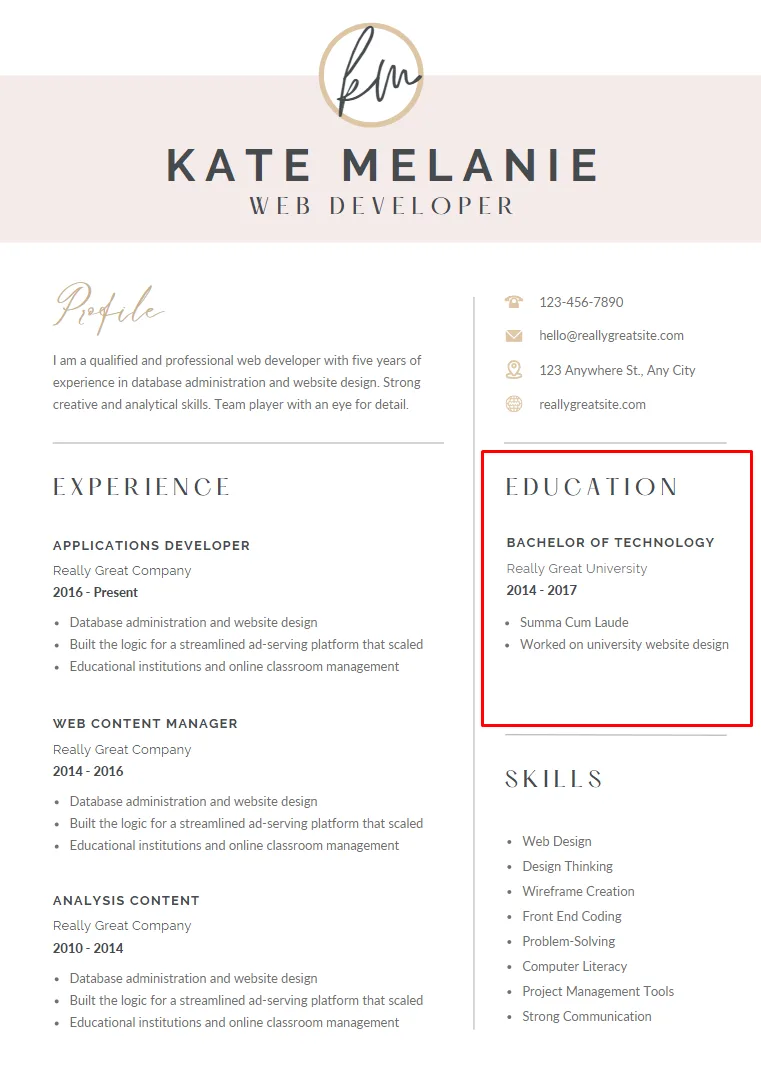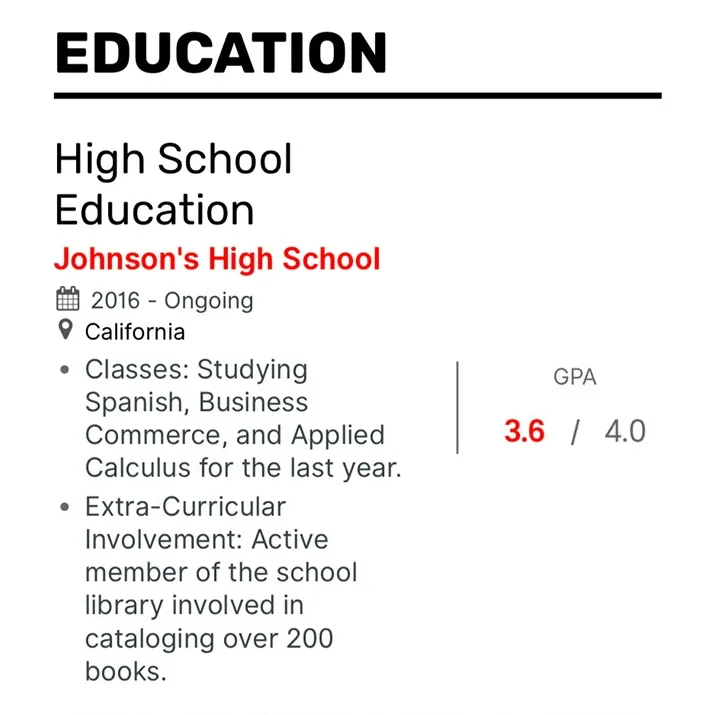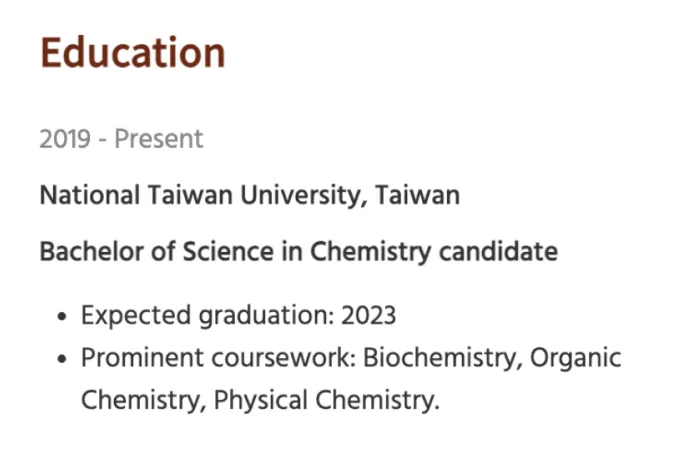Adding education to your resume is a crucial step in creating a professional document. After all, this section gives recruiters much-needed information about you and helps them decide if you’re the right person for the role they’re offering.
Fortunately, listing education on a resume is fairly straightforward in most cases. Nevertheless, there are always some vital aspects to consider, such as how detailed you should be or where to position this section.
That’s why we’ve created this handy guide—to help you get the most out of your education section and impress hiring managers. So, without further ado, let’s dive in!
Key Takeaways
Your education section should have a supplementary role in your resume. For this reason, you should put it after your work experience or to the side of the document.
When listing multiple degrees, use the reverse-chronological order and emphasize the highest one.
There are several key elements to include in this section, such as the name of your degree, the name and location of the institution that issued it, and years of attendance.
On top of that, there’s optional information to add in certain cases, including GPA, honors and awards, relevant coursework, extracurricular activities, etc.
Include your degree, even if your education is in progress or incomplete.
Where to Put Education on Your Resume

A place for education on your resume depends on your academic and professional experience, much like when deciding where to position a high school principal resume in your career progression. In general, it shouldn’t take over the whole document and be its main focus. Instead, you should emphasize your work history and use education information to supplement it.
As a result, this section usually comes after a work-related one. Check out the following educational qualification example on a resume to see what that looks like:

Of course, that kind of positioning isn’t set in stone—you can always get more creative. Another way to add education to your resume while keeping it complementary to the work experience is to place it to the side. Take a look at the next example:

How to Add Education to Your Resume
When including education in your resume, there are several vital elements to include:
Mandatory Education Section Information
Name of your degree
School’s name
School’s location
Years of attendance
If you’re adding more than one degree, use the reverse-chronological format that highlights the latest and most important ones.
To make this section pop, you can also include some additional information that could make it more effective. For example, if your GPA is 3.5 or higher, you should mention it. However, if you already have 5+ years of work experience, the hiring managers will be more interested in your employment history than your grades.
Any honors, courses relevant to the job you’re applying for, or exchange programs go a long way in impressing recruiters. Use bullet points for maximum effect, as lists make your resume neater and more readable.
Now let’s take a look at a suboptimal education section and then find a way to improve it:
Bad Example
EDUCATION
Westinghouse High School Chicago, IL 2013–2017 3.57 GPA
Bachelor of English Language and Culture University of Illinois at Chicago 3.17 GPA
While this section looks rich in content at first glance, a lot of it is obsolete information. Since the candidate listed their bachelor’s degree, it’s expected that they have a high school diploma, so it doesn’t need to be mentioned. They also flipped the order and listed the less important degree first.
Finally, the candidate didn't list the years they attended university, which would have given recruiters a better idea of their academic progress. On the other hand, they included their GPA, which, while decent at 3.17 out of 4, isn’t enough to impress.
Now, let’s fix that and see a better way to list education on a resume:
Education Section Example
EDUCATION
Bachelor of English Language and Culture University of Illinois at Chicago 2017–2020
Exchange Program in Copenhagen, Denmark
The candidate removed the content that wasn't useful, kept important information, and added a bullet point for an exchange program—that’s what a strong education section looks like!
Which Education Should You Add to Your Resume?

A general rule of thumb is to always list your latest and most impactful degree first. Then, depending on your academic and professional career, you can choose whether or not to add more content in reverse-chronological order.
Entry-Level Roles
As an entry-level candidate, chances are you don’t have a lot of work history to display. In that case, it’s perfectly fine to put more emphasis on your education.
You could be a recent graduate or someone who’s looking for a part-time high school job. In that case, you should include as much relevant information as possible, and even someone who’s still in school can create a captivating education section that way.
Start by including the essential information, such as the institution’s name and location, as well as years of attendance. Then strengthen the degree information with a bulleted list of the achievements you’re most proud of, along with any extracurricular activities, projects, coursework, and similar.
For example, here’s what a good high schooler’s resume section looks like:

Young Professionals
When adding education to a resume as a young professional, you should focus on quality over quantity. Since you already have a moderate amount of work history to showcase, your education section should allow it to be the main focus.
As a young professional, you’re most likely an undergraduate or have a higher degree. In that case, you should put your latest diploma front and center and back it up with any relevant courses and certifications. And since you’re already including at least an associate or bachelor’s degree, there’s no need to list your high school diploma.
You should include your undergraduate degree even if you’re still studying or have decided to drop out of college. To do that, omit the graduation date and mark it as “current.” You can also put an expected graduation date if it’s coming up soon. And if you dropped out, state how far you’ve gotten.
Let’s take a look at an example:

Seasoned Professional
A seasoned professional already has plenty of work experience under their belt. That’s when the professional history section becomes the bread and butter of a resume, and education plays more of a supporting role rather than being the center of their document.
After all, when you have 5+ years of work experience, that’s much more important than any course you took a decade ago. There’s no need to add your GPA either, as employers are much more interested in your professional proficiency than your grades. The same goes for any extracurricular activities or achievements obtained during college days.
Listing your undergraduate and graduate degrees in a clean and simple education section will give recruiters insight into your academic career and help paint a clearer picture of who you are as a candidate.
Here’s what this should look like:

15 Correct Examples of an Education Section on a Resume
Now that we've covered all of the important rules and guidelines for including education in your resume, let’s look at some more examples. There’s a solution for you regardless of whether you’ve just finished high school, your education is still in progress, or you have a college degree.
#1. High School Education/GED
A high school diploma and GED indicate similar levels of competence. Still, there are differences, both in the way they are obtained and how you should include them on your resume.
You typically get a high school diploma after four years of formal education. To earn your GED, you need to pass five subjects during a seven-hour exam. While the GED doesn’t require formal education, it still takes time to prepare for it.
Here's how to list education on your resume as a high school graduate:
High School Graduate Education Section Example
EDUCATION Payton College Preparatory High School Chicago, Illinois 2014–2018 3.59 GPA
If you’re still in high school, you should simply omit the finishing year like it’s done in the example below:
High School Student Education Section Example
EDUCATION Payton College Preparatory High School Chicago, Illinois 2023–Current
On the other hand, including a GED diploma or certificate can be as simple as in the following example:
GED Diploma Holder Education Section Example
EDUCATION
General Education Development Diploma NYS Education Department 2020
On a final note, you should only list your GED certificate or high school diploma if it’s your highest achievement. If you have a bachelor’s, master’s, or higher degree, avoid listing this one.
#2. Undergraduate Degree
If you’re a young professional who finished university and obtained an undergraduate degree, you want to focus on it and exclude your high school diploma. Here’s a basic example:
Undergraduate Education Section Example
EDUCATION
Bachelor in Electrical Engineering University of Texas at Dallas 2018–2021
If you have more than one major, list the one that is the most relevant to the job first, like in the following example:
Undergraduate (w/ More Than One Major) Education Section Example
EDUCATION
Bachelor in Electrical Engineering and Computer Engineering University of Texas at Dallas 2018–2021
To make the education section even stronger, include your GPA (if it’s 3.5 or higher), honors, achievements, exchange programs, and similar. Consider the following example to see how to make education on a resume more impactful:
Undergraduate (w/ Notable Achievements) Education Section Example
EDUCATION
Bachelor in Electrical Engineering and Computer Engineering University of Texas at Dallas 2018–2021
3.78 GPA
Magna cum laude
Exchange program in Stockholm, Sweden
#3. Graduate Degrees
As a graduate, you have more information to add to your education section. For example, you may want to list a dissertation, research work, fellowships, grants, scholarships, and other similar things if you have them. All those details will portray you as an ambitious and driven candidate.
Also, you should list both your graduate and undergraduate degrees in reverse-chronological order. Here’s what that would look like:
Graduate & Undergraduate Degrees Education Section Example
EDUCATION
Master of Science in Applied Mechanics California Institute of Technology 2018–2020
Salutatorian, Summa Cum Laude
Dissertation: Development and Testing of an Air Impingement Unit
—
Bachelor of Science in Mechanical Engineering California Institute of Technology 2015–2018
3.56 GPA
However, as mentioned previously, if you’re a seasoned professional with decades of experience, future employers will probably be more interested in your work history. In that case, you can stick to the most important points while providing fewer details.
Check out the example:
Graduate Degree w/ Work History Education Section Example
EDUCATION
PhD in Clinical Psychology University of Michigan 2019–Present
Dissertation: The Ecology of Cognitive Training and Aging
#4. Education in Progress
The fact that you haven’t obtained a degree yet doesn’t mean you can’t add it to your resume. Quite the contrary—you should still show where you’re at in your academic career.
There are two different ways an undergraduate student could list their education. If you’re currently studying, simply omit the graduation date and mark it as "current." Check out the following example:
Education in Progress Education Section Example
EDUCATION
Bachelor of Science in Civil Engineering Georgia Institute of Technology 2023–Current
If you are still in college and have an expected graduation date, you can note it in the education section. Here’s how to do it:
Education in Progress (w/ Expected Graduation Date) Education Section Example
EDUCATION
Bachelor of Science in Civil Engineering Georgia Institute of Technology 2023–2027 (Expected)
#5. Incomplete Education
What happens when, in the middle of your studies, you realize that college isn’t for you? Even if you drop out, you can still make the most out of your education by stating how far you’ve gotten in your academic endeavors. Let’s take a look at the example:
Incomplete Education Section Example #1
EDUCATION
Georgia Institute of Technology 2018–2020
58 credits completed toward B.Sc. in Civil Engineering
Here’s another one:
Incomplete Education Section Example #2
EDUCATION
Thomas Edison State University, Trenton, NJ 2017
30 credits completed toward B.Sc. of Science in Finance
#6. Certificates
If you have less important certifications that aren’t crucial for the job, you can include them in your education section. Similarly to the degrees, you want to include the name of the certificate, the institution issuing it and its location, the year, and (optionally) the expiration date. That would look like this:
Certifications Education Section Example
EDUCATION
Certified Nursing Assistant (CNA) 2020
American Institute of Healthcare & Technology, Connecticut
Another way to do it is to create a separate section and list your certifications there. This is the most common way, and it’s used when certificates are highly important and related to the job posting. As always, use the reverse-chronological format when listing multiple certificates.
Here’s an example:
Multiple Certifications Education Section Example
CERTIFICATES
Certification of Professional Achievement in Sustainable Finance (2019) Columbia University - Online course
Certificate in Financial Management (2017) Carey Business School, Baltimore, MD
Additionally, you can mention that you’re certified in a particular field in your resume summary or objective, like in the next example:

No matter what option you choose, you need to make sure that your certifications aren’t outdated or irrelevant to the job position.
Tips for Listing Your Education on a Resume
Now that we’ve learned all the rules and explored numerous examples, here are several bonus tips that will help you get the most out of your education section:
Education Resume Tips
You can spell out your full degree (e.g., “Bachelor of Applied Science”) or use an abbreviation (e.g., “BAS”).
Unless you’re a seasoned professional, include relevant achievements and coursework in your education section through bullet points. That makes them more prominent and helps you further highlight your proficiency.
However, if you have a lot of work experience, you should put less emphasis on your education. If you’ve been in the industry for more than five years, consider simply stating your degree, school’s name, and location.
If your degree isn’t particularly related to the job position but you went to a prestigious school, state its name first. If you went to a highly renowned university like Harvard, Oxford, or MIT, you could nonetheless state their names.
Use consistent formatting throughout your whole application. Education on your resume should look the same as all the other sections.
Closing Thoughts
As you can see, there’s often nothing too complex when adding education to your resume. Still, we’ve covered all of the fringe cases that would help you with any doubts you might have had!
If you follow the guidelines and study the examples, you'll have everything you need to make a great education section. That way, you’ll be one step closer to creating a perfect, job-winning resume!
Education on Resume FAQ
Here are the most frequently asked questions and answers about adding education to your resume.
#1. What should I write for educational qualification on my resume?
The essential information for education on your resume is:
Mandatory Education Section Information
Name of your degree
School’s name
School’s location
Years of attendance
Depending on your academic and professional career, here’s optional information you may want to add to your education section:
Optional Education Section Information
GPA (if it’s 3.5 or higher)
Relevant honors and achievements
Extracurricular activities, coursework, certificates, student exchange programs, and similar
#2. Should I add high school education to my resume?
You should only add your high school education if it’s your highest academic achievement. If you have a college degree or higher, a high school diploma is considered obsolete.
#3. Should I add my unfinished degree to my resume?
Showcase your unfinished degree even if you’re in the middle of your studies or if you dropped out of college. Here are three different cases and instructions on how to adjust the education section accordingly:
Unfinished Degree Education Section Tips
If you’re still a student with no graduation date in sight, omit it and write “current” instead.
If you have an expected graduation date, list it and add “expected” next to it.
If you dropped out after 2–3 years of studying, note how far you’ve gotten (XX credits completed toward B.Sc, for example).
If you dropped out after 2–3 years of studying, note how far you’ve gotten (XX credits completed toward B.Sc, for example).


